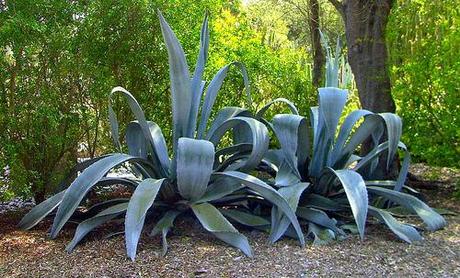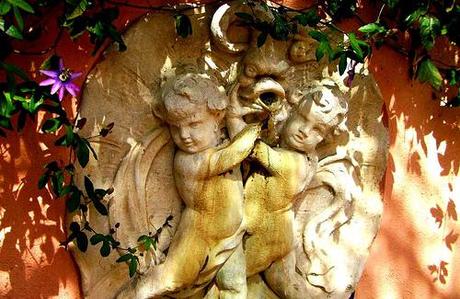
...softly sing in the dark'ning air
Though other lands of earth are fair
Forever and forever more
We will dream on the lotus shore
~ Mrs Gregory Smith, Atla: A story of the lost island, 1886.......
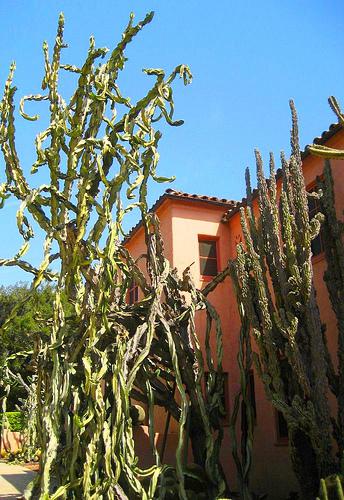
Lotusland. A magnificient, made-up world set in a small community where the fantastic is the norm. Estates here belong to some of the world's richest and most storied residents. And yet, even here, Lotusland retains a unique glamour and mystery that other estates just cannot claim.
A simple, elegant Mediterranean villa wears a sunny pink tuscan hue. It reclines near the base of the chaparral-covered mountains, and is all the more vivid for the turquoise dome of sky that shines above it most days. Euphorbia elegans twist dramatically along the front of the house, a phantasmagorical and rag-tag assemblage.
The natural landscape here - plain, foothill and mountain - is arid and dry. However, in the springtime, wildflowers and blooming chapparal fling a brief, colorful cloak over the vistas before the dry season comes. We see six months, usually more, without a drop of rain.
Lotusland is wrapped in a wide, stucco wall of an aging, auspicious pink; the very air is tinged with a propitious feeling of discovery and drama. Mysteries are sure to be revealed. And more enticingly, some of its secrets are sure to be kept.
This is an environment extraordinaire.
Exquisite. Edgy. Wild.
Carefully maintained. Growing. Evolving. Vibrant life - 37 acres of it. This is a plot of land that seems to have dreamed itself into being, drawn to itself the perfect succession of designers, gardeners, curators, and caretakers.
I revisited Lotusland last week. It was a sunny day in early spring, the recent spate of rainstorms on hold - briefly.
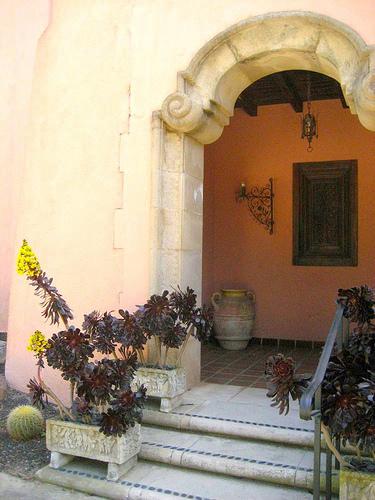
The story of Lotusland began in 1882, when Ralph Kinton Stevens, a transplanted Englishman who became a zealous convert to the West Coast, settled here. He was a natural plantsman, an avid horticulturist who began filling the land with a sampling of trees and plants from around the world: palms, avocados, lemons, oranges, olives, bananas, mangos, and more. He named the land, Tanglewood. He built his family home here, planted orchards, raised his children and reveled in the life he had created.
He worked closely with other local plantsmen, Dr Doremus, and Dr Franchesci, who became horticultural goodwill ambassadors, encouraging Southern Californians to create gardens using varieties of plants gathered from around the globe. Stevens also opened a nursery at Tanglewood, offering an ever-changing selection of unique plants.
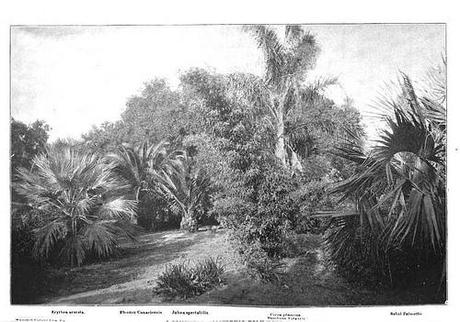
The frontispiece shows some of the finest specimens to be seen in the country. The slender growing, feathery-headed palm in the center is Cocos plumosa from Brazil; on the right corner stands the Sabal Palmetto from our Southern Atlantic coast; on the left, Palma Azul or Blue Palm, Krythea armata from lower California, while in the background are to be seen two huge specimens of the Palma de miel or Coquito Juba a spectabilis from Chile, and of Phoenix Canadensis from the Canary Islands , which has become so popular all over California. Under the Cocos is a young clump of giant bamboo, Bambusa vulgaris from India.
This picture was taken in El Montecito near Santa Barbara at the residence of the late Kinton Stevens who was one of the most enthusiastic pioneers to enrich California with plants from other lands ~Santa Barbara, Cal.
~ Dr F Franchesci, Out West Magazine, 1896
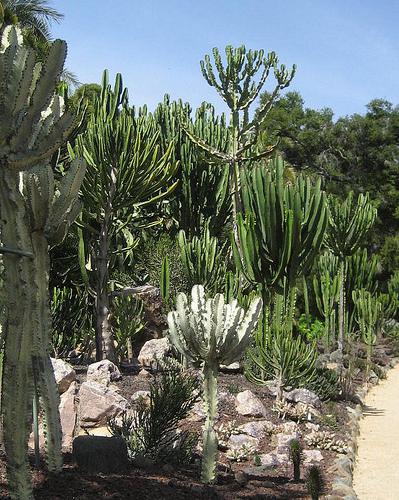
When Stevens' died, the estate languished, was rented out, then leased, until it was purchased by George Owen Knapp in 1913. Knapp, a philanthropist, and his wife, were generous benefactors to their local community and several prominent American institutions. But when they were home in Montecito, they tended their home and beloved garden.
In 1916, Palmer Gavit and his wife purchase the property, and name it Cuesta Linda - Beautiful Hill. Later, they commission Reginald Smith, renowned architect, to design the Mediterranean-style home. Construction was completed in 1920. The original gardens had matured beautifully, and had been embellished in the ensuing decades since Stevens had first stepped foot on the soil. Soon, they hired George Washington Smith, another luminary architect, who designed the pink wall, the pool and pavilion, garages, and other scattered buildings - and imbued the property with a new, fresh vision.
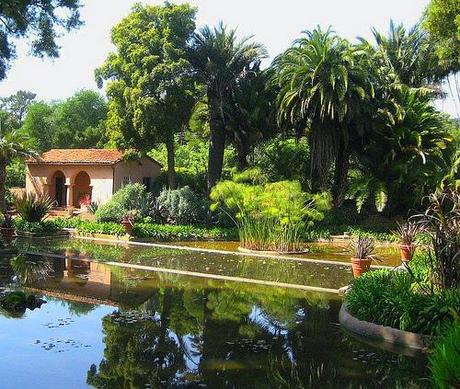
In 1941, Madame Ganna Walska first appeared at the property on East Valley Road. Ganna Walska, a Polish beauty, traveled the world and scandalized society in almost every country because of her her numerous and well-publicized affairs and marriages, her voracious appetite for luxury and finery, and her bold, audacious manner.
Ganna Walska liked Cuesta Linda, purchased it, and named it Tibetland. She brought her newest husband here, Number 6 on the list, and endeavored to create a spiritual retreat.
Not long after that, her marriage fell apart and the husband moved out.
Now, it was just Ganna Walska and the Garden.
Although the spiritual retreat never materialized in the way she had imagined, a transformation had begun. Eventually, Madame's passions, formerly reserved for men, travel, luxury - were subsumed by her love of the garden. She put away fashion and frivolity. She dug her hands into the black earth. She walked barefoot on the grass. She swam naked in the pool by moonlight. She planted trees and saw them grow. she picked lemons and clementines from the orchard. She gathered baskets of rose blooms and drank in their fragrance. She potted and pruned her geraniums. She pulled weeds, clipped hedges, pruned tree limbs.
She engaged Lockwood de Forest, artist and landscape architect, as her partner in the newest transformations that were changing the face of Lotusland forever.
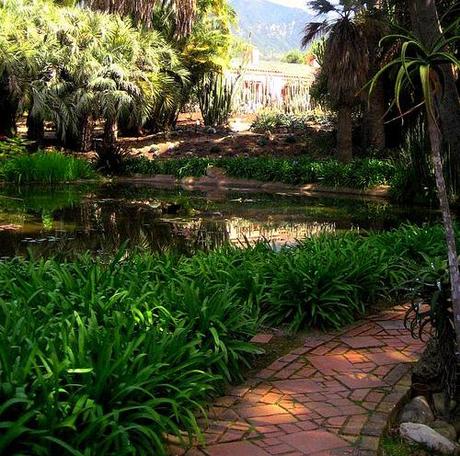
She also included Ralph Stevens in her plans. Stevens, Ralph Kinton Steven's son, had grown up on the land, and knew it through all its incarnations. He had a hand in forming Lotusland, as well. He designed the iron gate that faces Sycamore Canyon Road; he helped to redesign several areas of the garden.
Eventually, Joseph Knowles, a well-known artist and local teacher, worked with Madame in designing the aloe garden and the pool that is edged with a ring of abalone shells.
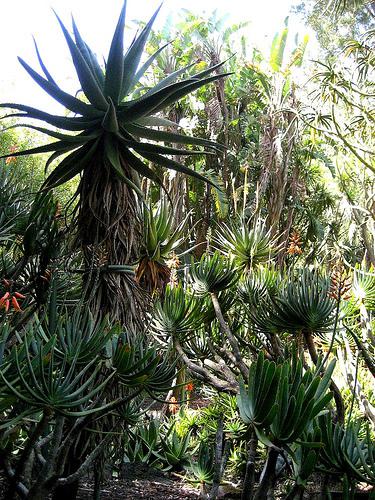
In the 1960s, Madame installed the Japanese Garden with the help of Frank Fuji, who recently retired from his 50-year tenure in the Garden. He worked at Lotusland until he was 90 years old.

The garden continued to develop through the decades. Madame Ganna Walska filled the swimming pool with mud - and lotus plants. Every August, the shaded pool is transformed with tall, statuesque lotus flowers that are held aloft on six-foot-tall stems. The nearby pools are covered with delicate waterlilies.
The rich, rosy colors kaleidoscope in the dappled shade; the quiet summer heat hums with life; still water reflects a sky of sharp china-blue. The meandering red brick pathways, combined with all before you - leaves you ennervated - satisfyingly so.
Eventually, with Madame's passing, her dream of a creating retreat was realized, in a way. Lotusland became a retreat from everyday life. It opened as a public garden; extensively-trained docents offer guided tours twice daily, from February through November.
Once visitors pass through the tall iron gates, immersion into this retreat from modern life is complete. At least for a few hours.
I worked for a season in the Garden Shop at Lotusland. I would arrive on Saturday mornings, open the shop, prepare for the first tour that began at 10:00am.
Often, I was the first person in the garden. I began my morning walk through the fern and begonia gardens. Deeply shaded, the path was flecked on either side with blossoms from begonias; the fragrant blooms from the huge angels' trumpet (datura) dripped with the remnants of last night's fog.
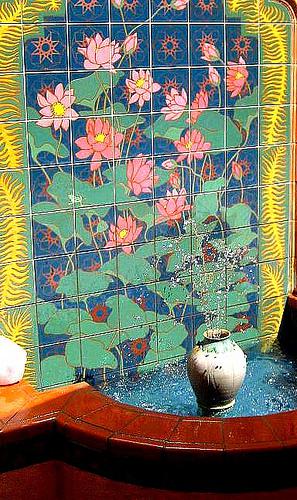
As I circled through the Japanese garden, I would notice the azeleas in bloom, or the camellias, or the reddening of the Japanese maple leaves, each in its season. One morning, I saw a pair of blue herons in the pond, feasting on glittering red koi, while the life-sized brass crane statues stood sentinal.
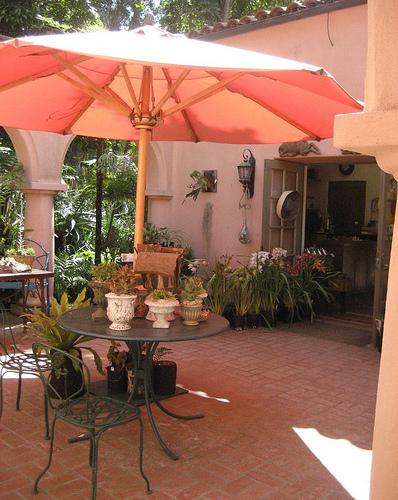
Between tours, I would sweep, and clean, and then sit on the patio and read the newest gardening books: The Gardens of Columbia, Seaside Gardening, The English Cottage Garden, Santa Barbara Style, The Trees of Santa Barbara, and many others.
At lunch, I would walk the garden, and in the heat of summer, I would linger in the cool tropical garden, where large philodenrons and bananas mingle beside the soft bark trails, and dozens of epiphyites hang above the pathways.
In the springtime that year, we all watched as a pair of tiny towhees selected a potted plant on the patio as the perfect nesting site. Week after week, I watched and protected them from any disturbance. There, within the rim of the black one-gallon pot, beneath the shelter of the plant, they nested and hatched their eggs. K was there on the day the birds taught their babies to fly. She saw them fluff and flutter and falter - suddenly they could fly and they were gone.
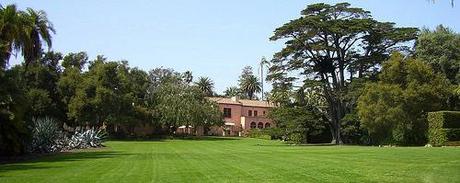
There are daily treasures, small and large. There are gardens galore to discover: the Theater Garden, the Cycad Garden, the bromeliads. I was there when the cactus garden had just been planted. It seemed, to me, stark and out of place. In seeing it again, recently - it has acclimated, and settled. It belongs. It is beautiful.
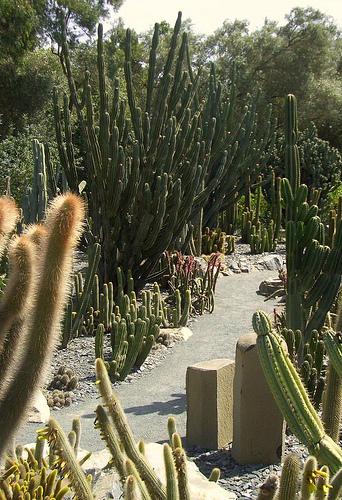
I assure you - whether you visit in spring or autumn, in sunshine or on a showery day - the garden is a delight. There is never a bad day to visit Lotusland. It is a living creature, a place of many faces and guises.
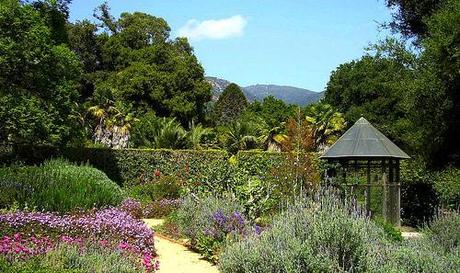
I was passing through the butterfly garden one afternoon, when a cloud of monarch butterflies drifted over the hedges and tumbled above the flowers as they flew along. I was mystified. From whence would a cloud of butterflies appear, and where could they be going?
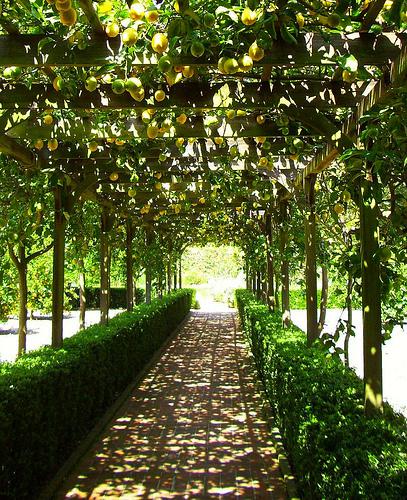
Last week, while visiting the garden aviary, we saw the turtle doves nuzzle and flutter - the early steps in their mating dance.
Lizards live here, and rabbits wild - and animals created from the plants themselves.
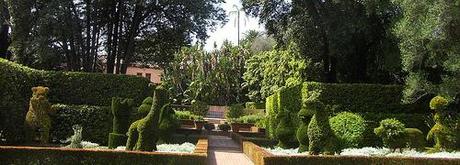
Lotusland has launched a new website. View the map to take an interactive tour, learn about upcoming events, make a reservation to take a real-life tour.
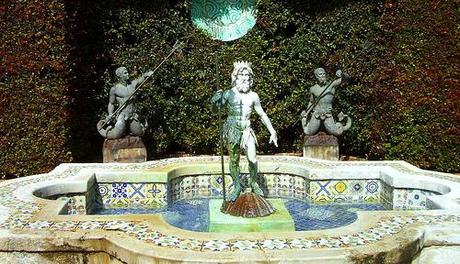
The enchantment here is real. It was created - for all of us - by some of the world's most interesting and visionary gardeners. It is lovingly tended and maintained today, by interesting and visionary gardeners, scholars, volunteers, and trustees who oversee the health and vibrant life of the garden.
It is a community resource, a teaching garden. It is a living legacy, a labor of love, a world-class historic and horticultural preserve.
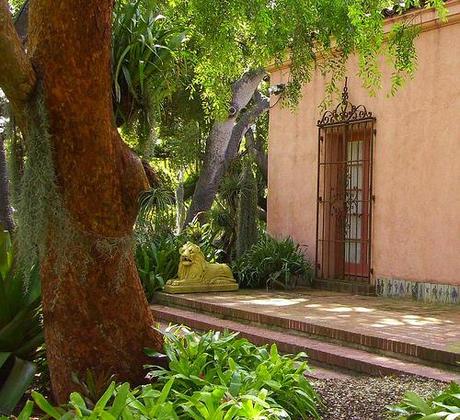
You must come and see it for yourself.
